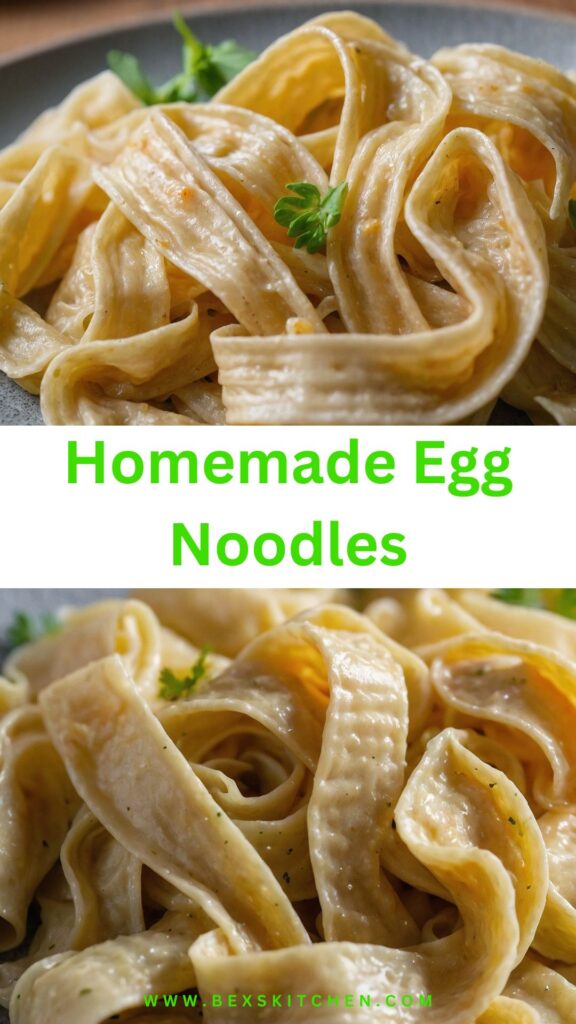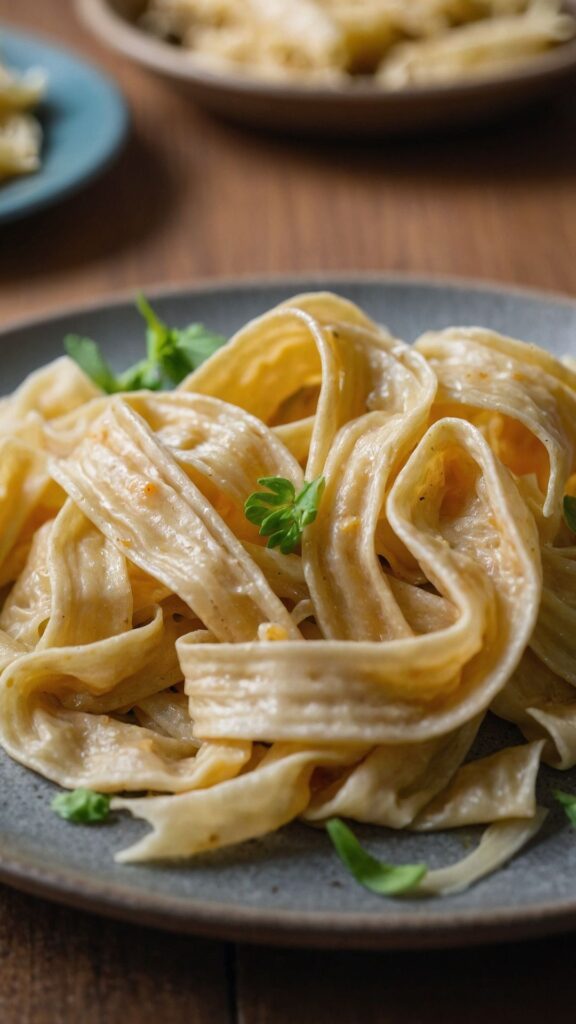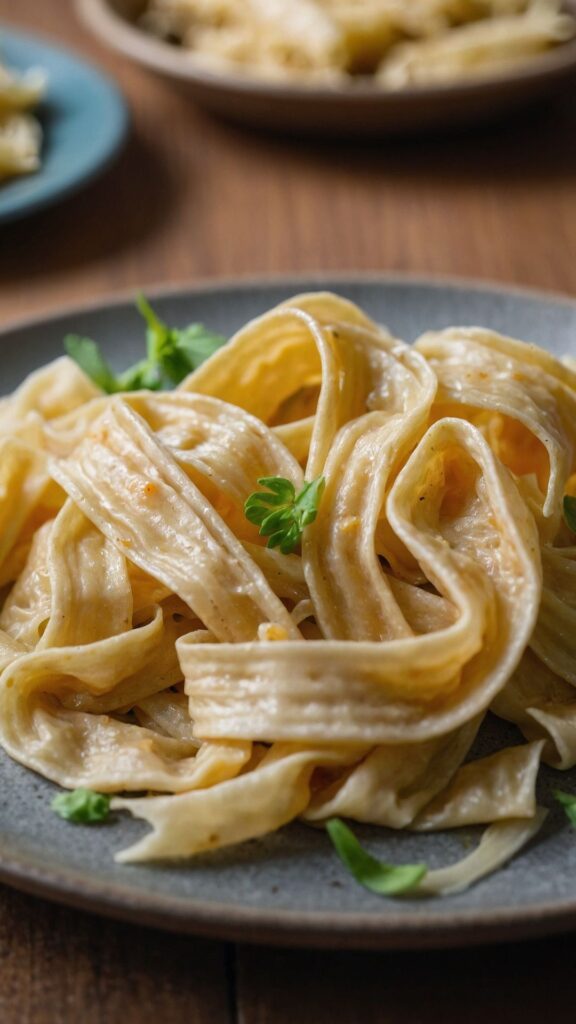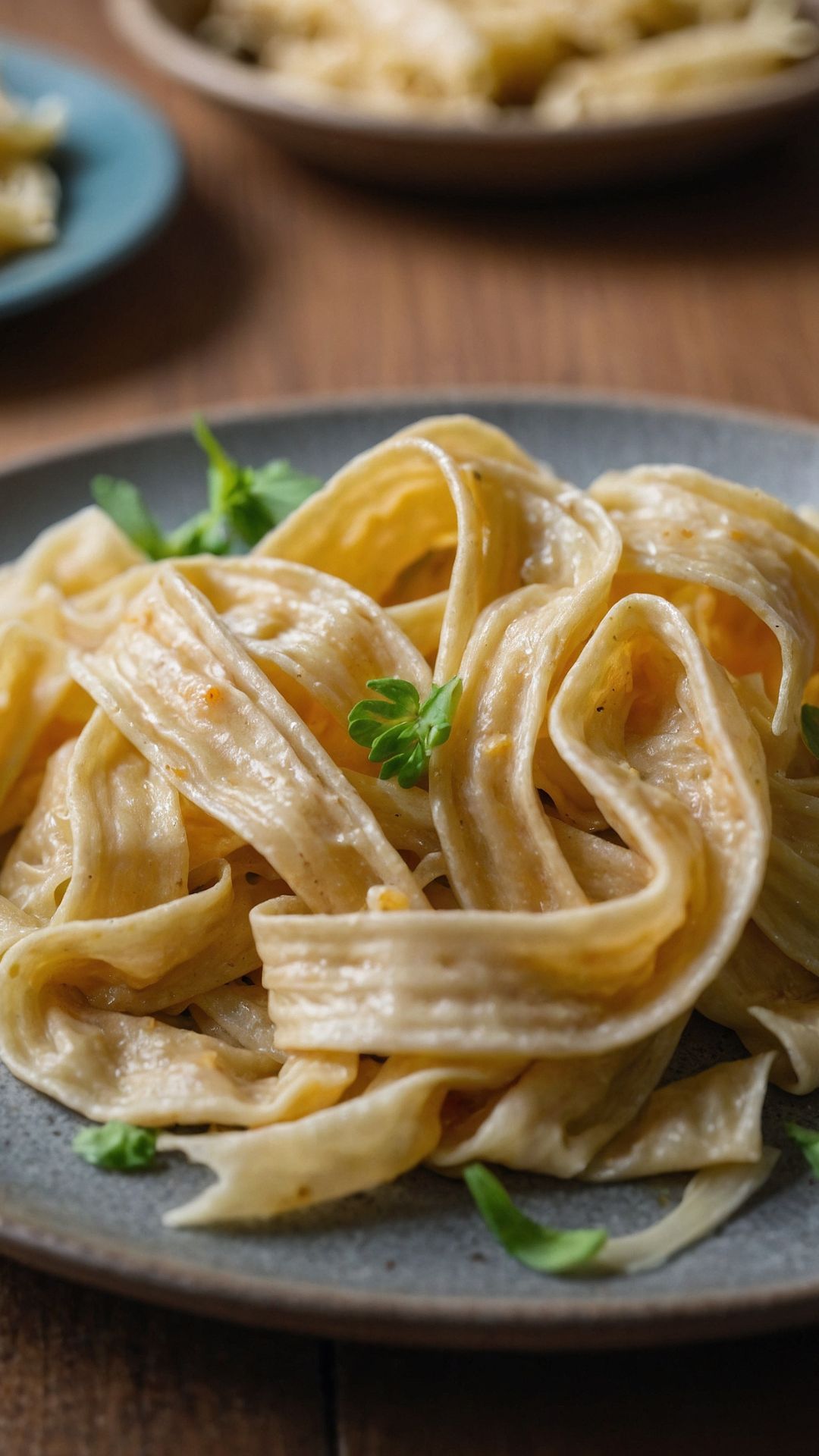Before diving into the delightful world of homemade egg noodles, let’s chat about some perfect companions for this dish. Homemade pasta is incredibly versatile, so consider pairing it with these:
1. Rich, Hearty Sauces: Think marinara, alfredo, or a homemade Bolognese. These sauces complement the texture of the noodles beautifully and boost flavor.
2. Fresh Vegetables: Toss in sautéed or fresh veggies like spinach, cherry tomatoes, or zucchini. They add color, crunch, and nutrition to your meal.
3. Protein Options: Grilled chicken, shrimp, or even sautéed mushrooms can elevate your dish and make it filling.
These options not only enhance the flavor profile but also provide nutritional balance. Now, let’s get down to the art of making homemade egg noodles!

Imagine the satisfaction of twirling fresh homemade egg noodles on your fork, each one bursting with a tender, chewy texture that store-bought options just can’t match. Homemade egg noodles aren’t merely a meal; they are an experience. The creation process is straightforward, fun, and involves ingredients you might already have at home.
I’ve spent countless evenings experimenting, and I can confidently say that simple pleasures often yield the most profound satisfaction. Making your own noodles is not just about filling your stomach; it’s about creating something special for yourself or your loved ones. Trust me, this is an adventure you want to embark on.
What Are Homemade Egg Noodles?
Homemade egg noodles are a type of pasta made from a simple combination of flour and eggs. Traditionally, they are rolled out into thin sheets and cut into strips. These noodles are richer and chewier than standard dried pasta, thanks to the egg content. Whether you use them in soups, stir-fries, or with sauces, homemade egg noodles stand out for their fresh taste and texture.
Why This Recipe Works?
1. Simplicity in Ingredients
This recipe calls for seven basic elements, making it accessible. It doesn’t require fancy equipment or ingredients. Just flour, eggs, salt, and a little water. No need to hunt for exotic items.
2. Customizable to Your Liking
You can easily alter the flavor profile of your noodles. Want a hint of garlic? Add powdered garlic. Prefer a whole grain option? Swap in whole wheat flour. The sky’s the limit for creativity.
3. Freshness Matters
There’s something special about fresh pasta. Store-bought pasta can sit on shelves for weeks; fresh noodles offer a taste that’s simply unbeatable. They cook differently too, absorbing sauces better and creating a satisfying bite.
4. Rewards of Personal Touch
Every batch you make has a unique touch. When you create these noodles from scratch, there’s a deep sense of accomplishment. It transforms a simple meal into a heartfelt experience.
You will also like the following Lunch recipes!
- Turkey Stuffed Peppers With Rice And Tomato Recipe
- Panera Bread Mac And Cheese
- How to make Old Fashioned Potato Soup
Ingredients You’ll Need to Make This Dish
Gather these straightforward ingredients before you start:
- 3 large egg yolks (room temperature for better mixing)
- ¼ teaspoon ground white pepper (optional for flavor enhancement)
- 1 teaspoon olive oil (to improve dough texture)
- 2 teaspoons kosher salt (finely ground for better mingling)
- ¼ cup filtered water (adjust as necessary)
- 2 cups unbleached all-purpose flour (for that delightful chew)
- 1 large whole egg (room temperature adds richness)

How to Make Homemade Egg Noodles?
Let’s take the plunge into making these delightful noodles. As a kid, I always enjoyed pasta-making days in the kitchen. The mess, the flour dusted everywhere—it was all part of the fun. Now, let’s get rolling!
Step 1: Prepare the Dough
Start by combining the flour and salt in a bowl. Make a well in the center, then add the egg yolks, the whole egg, and olive oil. Gradually mix in the flour with a fork until the dough begins to come together. If you’re feeling adventurous, a pinch of pepper adds an intriguing twist.
Step 2: Knead, Knead, Knead
Once combined, dump the dough onto a floured surface. Knead it with your palms. This is your chance to work up a bit of muscle. The texture should be smooth and elastic, which might take about 5–10 minutes. Say goodbye to stress and hello to homemade noodles!
Step 3: Rest the Dough
Wrap your kneaded dough in plastic wrap and let it rest for about 30 minutes. This allows the gluten to relax, making it easier to roll out later.
Step 4: Roll It Out
After the dough has rested, split it into smaller portions. Roll one portion out on a floured surface until it’s about 1/16-inch thick. Keep the rest wrapped to prevent drying out.
Step 5: Cut the Noodles
Once rolled out, use a sharp knife or a pizza cutter to slice the dough into strips of your desired width. Believe me, this is a satisfying moment!
Step 6: Dust and Dry
Dust the cut noodles with flour to prevent sticking, and lay them out on a clean surface or a kitchen towel. Let them dry for about 15 minutes.
Step 7: Cook and Serve
Boil a large pot of salted water. Once it’s bubbling vigorously, gently drop in the noodles. Fresh noodles only take about 2–3 minutes to cook. Once al dente, drain and toss with your preferred sauce or toppings.
Tips & Tricks
To elevate your homemade egg noodle experience, consider these tips:
- Select Quality Flour: Using high-quality flour can impact the texture. Try to find unbleached flour for the best result.
- Room Temperature Ingredients: Eggs blend seamlessly into the dough when they’re at room temperature.
- Experiment with Thickness: If you like thicker pasta, adjust your rolling technique accordingly.
- Don’t Skimp on the Resting Time: Giving your dough time to rest makes it much easier to roll out.
- Cook Immediately or Store Dry: You can cook the noodles right away or let them dry and store them for later use.
Nutrition Information
When made with the ingredients listed, homemade egg noodles roughly contain:
- Calories: 200 (per serving)
- Protein: 8g
- Fat: 2g
- Carbohydrates: 40g
- Fiber: 2g
These noodles are filled with energy, perfect for a fulfilling meal!
How Do You Store The Leftovers?
So, you made more than you can eat? No problem! Store leftovers in an airtight container. If cooked, keep them in the fridge for up to 3 days. If uncooked, these noodles can be dried completely and stored in a cool, dry place for up to 2 months. Just make sure you give them a little dusting of flour to prevent sticking!

What Sides Would Complement Homemade Egg Noodles?
You’ve got your egg noodles, but what about sides? Here are some great companions:
1. Garden Salad
A fresh vegetable salad hydrates and balances a rich pasta dish. Toss together mixed greens, tomatoes, cucumbers, and a light vinaigrette. The crunch and juiciness will offer a refreshing contrast.
2. Garlic Bread
Ah, garlic bread—a classic! The buttery, garlicky delight is a crowd favorite and perfect for scooping up any leftover sauce. It’s an appetizer that pairs nicely with the hearty noodles.
3. Sautéed Greens
Stir-fried spinach or kale with olive oil and garlic provides a healthy side. The subtle bitterness of the greens complements the richness of the noodles perfectly.
What Alternatives Can You Use for the Ingredients?
Not all flavors and ingredients might be at your disposal, and that’s okay. If you find yourself missing some items from the list, here are some ways to adapt:
1. Flour Alternatives
If you can’t find all-purpose flour, consider using semolina flour or even whole wheat flour, although it may change the noodle texture slightly.
2. Egg Substitutes
In a pinch, consider using aquafaba (the liquid from canned chickpeas) and a bit of adjusted flour. It won’t replicate the egg perfectly but can work in a bind.
3. Olive Oil
For a different flavor, avocado oil or melted butter can work. The result may differ subtly, but the recipe will remain delicious.
4. Water Alternatives
If you don’t have filtered water, tap water will suffice. The purity of filtered water aids in flavor, so just keep it cold.

Equipment
- bowl
Ingredients
- 3 large egg yolks room temperature for better mixing
- ¼ teaspoon ground white pepper optional for flavor enhancement
- 1 teaspoon olive oil to improve dough texture
- 2 teaspoons kosher salt finely ground for better mingling
- ¼ cup filtered water adjust as necessary
- 2 cups unbleached all-purpose flour for that delightful chew
- 1 large whole egg room temperature adds richness
Instructions
Step 1: Prepare the Dough
- Start by combining the flour and salt in a bowl. Make a well in the center, then add the egg yolks, the whole egg, and olive oil. Gradually mix in the flour with a fork until the dough begins to come together. If you’re feeling adventurous, a pinch of pepper adds an intriguing twist.
Step 2: Knead, Knead, Knead
- Once combined, dump the dough onto a floured surface. Knead it with your palms. This is your chance to work up a bit of muscle. The texture should be smooth and elastic, which might take about 5–10 minutes. Say goodbye to stress and hello to homemade noodles!
Step 3: Rest the Dough
- Wrap your kneaded dough in plastic wrap and let it rest for about 30 minutes. This allows the gluten to relax, making it easier to roll out later.
Step 4: Roll It Out
- After the dough has rested, split it into smaller portions. Roll one portion out on a floured surface until it’s about 1/16-inch thick. Keep the rest wrapped to prevent drying out.
Step 5: Cut the Noodles
- Once rolled out, use a sharp knife or a pizza cutter to slice the dough into strips of your desired width. Believe me, this is a satisfying moment!
Step 6: Dust and Dry
- Dust the cut noodles with flour to prevent sticking, and lay them out on a clean surface or a kitchen towel. Let them dry for about 15 minutes.
Step 7: Cook and Serve
- Boil a large pot of salted water. Once it’s bubbling vigorously, gently drop in the noodles. Fresh noodles only take about 2–3 minutes to cook. Once al dente, drain and toss with your preferred sauce or toppings.
Notes
- Select Quality Flour: Using high-quality flour can impact the texture. Try to find unbleached flour for the best result.
- Room Temperature Ingredients: Eggs blend seamlessly into the dough when they’re at room temperature.
- Experiment with Thickness: If you like thicker pasta, adjust your rolling technique accordingly.
- Don’t Skimp on the Resting Time: Giving your dough time to rest makes it much easier to roll out.
- Cook Immediately or Store Dry: You can cook the noodles right away or let them dry and store them for later use.
Nutrition
Frequently Asked Questions
1. How long can I store homemade egg noodles?
Homemade egg noodles can last in the refrigerator for up to three days. For longer storage, dry them completely, and they will stay good in a sealed container for up to two months.
2. Can I freeze homemade egg noodles?
Absolutely! Freeze uncooked noodles in a freezer bag for up to three months. Just drop them directly into boiling water without thawing for a quick meal.
3. Can I make egg noodles without a rolling pin?
Yes! A clean wine bottle can substitute for a rolling pin or even your hands if you’re feeling adventurous. The goal is even dough thickness.
4. Can I add spices to the noodle dough?
Definitely! Feel free to incorporate herbs like basil or oregano directly into the dough for additional flavor.
5. How can I fix dough that is too dry?
If your dough is crumbly or hard, gradually add a bit of water one tablespoon at a time while kneading until it becomes smooth and elastic.
6. What sauce pairs best with homemade egg noodles?
Rich sauces like Bolognese or creamy alfredo work exceptionally well, but a light olive oil and garlic sauce can allow the noodles’ flavor to shine through.
Conclusion
Homemade egg noodles are a simple yet rewarding venture that can transform meal times. They bring a sense of joy and satisfaction with each bite, serving as the perfect base for various sauces and sides. With a handful of ingredients and a little time, you can create something truly special.
Plus, the opportunities for customization are endless. So, roll up your sleeves and embark on this culinary adventure. Your taste buds will thank you! Ultimately, homemade egg noodles deliver an experience that’s far beyond their dried counterparts, reminding us that sometimes, the best things in life are crafted with love and care.
